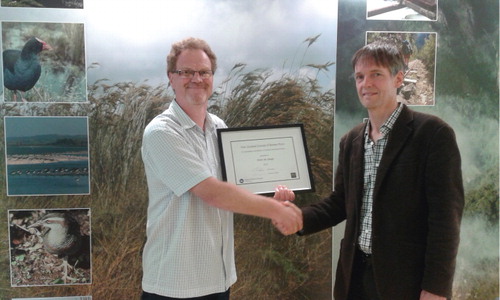It is my pleasure and privilege to assume the role of Senior Editor of the New Zealand Journal of Botany. Launched in 1963, the Journal has a proud 50-year history as the go-to publication for anyone interested in the strange and wonderful botany of the New Zealand archipelago. As a broad-spectrum journal, it has published landmark articles on all aspects of the biology of photosynthetic organisms and fungi, including conservation biology (e.g. de Lange et al. Citation2009), ecology (Wardle Citation1965; Ogden Citation1985), evolution (Wardle Citation1963; Raven Citation1973), genetics (Dawson Citation2000), molecular systematics and phylogeography (Wagstaff & Garnock‐Jones Citation1998; Heenan et al. Citation2010), morphology (Pocknall Citation1981), palaeoecology (McGlone & Topping Citation1977), physiology (Bannister Citation2007), reproductive biology (Godley Citation1979; Lloyd & Webb Citation1986) and taxonomy (Connor & Edgar Citation1987; Garnock-Jones Citation2014).
In 2002, the Journal widened its compass to welcome contributions from the southern hemisphere in general—a natural progression, in view of New Zealand's floristic connections with South America, Australia, New Caledonia and other southern landmasses. Having worked as a plant ecologist in Chile and Australia, I am fortunate to be able to draw on knowledge of the flora and vegetation of two other southern hemisphere countries from which the Journal receives many submissions.
The New Zealand Journal of Botany is a journal with a sense of place, and a global readership. Although about three quarters of articles published in the Journal since 2010 focus on the biota of New Zealand, over 40% of downloads of articles in 2013 were from overseas, with almost 20% from North America and Europe. Similarly, in 2013, about 60% of citations of articles published in the Journal were by scientists working in other countries. So, I would like to take this opportunity to remind potential authors that the work you publish in this journal reaches well beyond our own shores, and is read and cited by colleagues from all around the world.
Authors can expect a rigorous, fair and supportive review process. The Journal has no page charges except for colour figures in the printed version, and authors have the option of free colour figures in the online version. The Journal is fortunate to be able to count on a team of experienced editors who offer a wide range of expertise, and who are committed to the Journal. I would like to thank the Editorial Committee for their hard work over the past few years, and I look forward to establishing a good working relationship with them. The Journal is well supported by both the Royal Society of New Zealand and our publishing partners Taylor & Francis, with whom I also look forward to a productive and enjoyable partnership.
Journal Prize 2014
I am pleased to announce that Peter de Lange has been selected as the recipient of the New Zealand Journal of Botany’s 2014 prize for sustained excellence in contributions to southern hemisphere botany (). To mark its 50th birthday in 2013, the Journal initiated an annual prize for outstanding contributions to the botany of the southern hemisphere. The award will alternate annually between established researchers who have a sustained record for excellence, and early-career researchers who have published a significant article in a recent issue of the Journal. According to the records supplied by Taylor & Francis, Peter de Lange has authored 21 publications in the New Zealand Journal of Botany between 2009 and 2013, mainly in plant systematics and conservation biology. Those articles have been very influential, already attracting 131 citations (as of December 2014), at an average of 6.2 citations per article. This body of work has significantly advanced our knowledge of plant diversity in New Zealand, and done a great service to the cause of conservation. On behalf of the Editorial Committee, I congratulate Peter on his outstanding contribution!
Chris Lusk
Senior Editor
References
- Bannister P 2007. Godley review: a touch of frost? Cold hardiness of plants in the southern hemisphere. New Zealand Journal of Botany 45: 1–33.
- Connor HE, Edgar E 1987. Name changes in the indigenous New Zealand flora, 1960–1986 and Nomina Nova IV, 1983–1986. New Zealand Journal of Botany 25: 115–171.
- Dawson MI 2000. Index of chromosome numbers of indigenous New Zealand spermatophytes. New Zealand Journal of Botany 38: 47–150.
- Garnock-Jones PJ 2014. Evidence-based review of the taxonomic status of New Zealand's endemic seed plant genera. New Zealand Journal of Botany 52: 163–212.
- Godley EJ 1979. Flower biology in New Zealand. New Zealand Journal of Botany 17: 441–466.
- Heenan PB, Mitchell AD, de Lange PJ, Keeling J, Paterson AM 2010. Late-Cenozoic origin and diversification of Chatham Islands endemic plant species revealed by analyses of DNA sequence data. New Zealand Journal of Botany 48: 83–136.
- de Lange PJ, Norton DA, Courtney SP, Heenan PB, Barkla JW, Cameron EK et al. 2009. Threatened and uncommon plants of New Zealand (2008 revision). New Zealand Journal of Botany 47: 61–96.
- Lloyd DG, Webb CJ 1986. The avoidance of interference between the presentation of pollen and stigmas in angiosperms I. Dichogamy. New Zealand Journal of Botany 24: 135–162.
- McGlone MS, Topping WW 1977. Aranuian (post-glacial) pollen diagrams from the Tongariro region, North Island, New Zealand. New Zealand Journal of Botany 15: 749–760.
- Ogden J 1985. An introduction to plant demography with special reference to New Zealand trees. New Zealand Journal of Botany 23: 751–772.
- Pocknall DT 1981. Pollen morphology of the New Zealand species of Dacrydium Selander, Podocarpus L'Heritier, and Dacrycarpus Endlicher (Podocarpaceae). New Zealand Journal of Botany 19: 67–95.
- Raven PH 1973. Evolution of subalpine and alpine plant groups in New Zealand. New Zealand Journal of Botany 11: 177–200.
- Wagstaff SJ, Garnock‐Jones PJ 1998. Evolution and biogeography of the Hebe complex (Scrophulariaceae) inferred from ITS sequences. New Zealand Journal of Botany 36: 425–437.
- Wardle P 1963. Evolution and distribution of the New Zealand flora, as affected by quaternary climates. New Zealand Journal of Botany 1: 3–17.
- Wardle P 1965. A comparison of alpine timber lines in New Zealand and North America. New Zealand Journal of Botany 3: 113–135.


